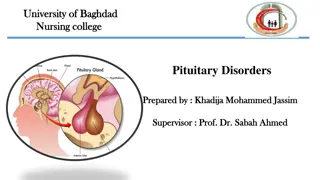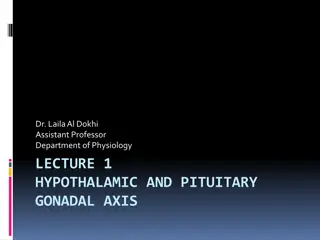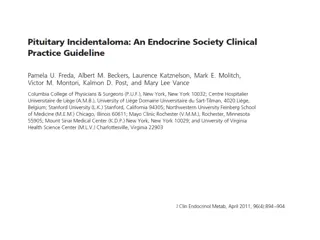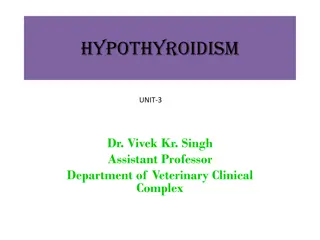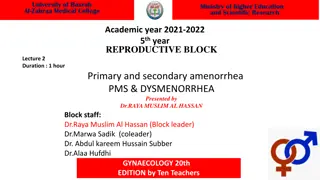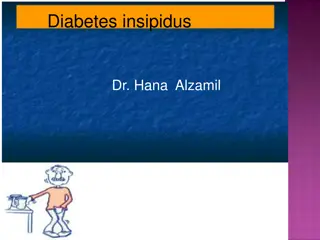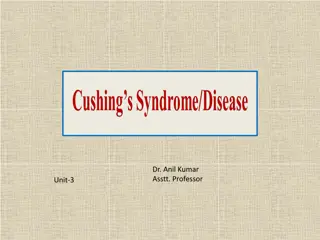Understanding Pituitary Incidentalomas: Causes, Diagnosis, and Management
Pituitary incidentalomas are unexpected lesions found during imaging studies for unrelated reasons. Evaluation and management recommendations rely heavily on clinical experience due to limited literature on the topic. Etiology includes mostly pituitary adenomas and a small percentage of nonpituitary masses. The prevalence of pituitary incidentalomas is around 10.6%, with nearly all being microadenomas. Further research is needed to determine optimal management strategies for these lesions.
Download Presentation

Please find below an Image/Link to download the presentation.
The content on the website is provided AS IS for your information and personal use only. It may not be sold, licensed, or shared on other websites without obtaining consent from the author. Download presentation by click this link. If you encounter any issues during the download, it is possible that the publisher has removed the file from their server.
E N D
Presentation Transcript
Pituitary Incidentaloma A.Amouzegar Endocrine Research Center, Research Instutute for Endocrine sciences
Definition of pituitary incidentaloma A pituitary incidentaloma is a previously unsuspected pituitary lesion that is discovered on an imaging study performed for an unrelated reason By definition, the imaging study is not done for a symptom specifically related to the lesion, such as visual loss, or a clinical manifestation of hypopituitarism or hormone excess, but rather for the evaluation of symptoms such as headache, or other head or neck neurological or central nervous system complaints or head trauma
The evidence valid estimates of the pretest probability of an abnormal test of pituitary function could not be definitively determined because literature on this topic is sparse Therefore, recommendations for the evaluation relied heavily on clinical experience Data on the prevalence of hormone hypersecretion in pts with an incidentaloma are available from small observational studies (most retrospective) and estimated from autopsy data Few data are available for or against a nonsurgical approach to management of asymptomatic pituitary incidentalomas
Etiology of pituitary incidentalomas In a series of sellar masses that required surgery, 91% were pituitary adenomas and about 9% were nonpituitary in origin, of which most were craniopharyngiomas and Rathke s cleft cysts 1999 Differential diagnosis of sellar masses. Endocrinol Metab Clin North Am 28:81 117, vi The 334 pituitary adenomas found the 3048 autopsy cases have been examined, finding 39.5% staining for PRL 13.8% staining for ACTH 7.2% staining for gonadotropins or a-subunits, 1.8% staining for GH 0.6% staining for TSH 3.0% staining for multiple hormones
Epidemiology of pituitary incidentalomas The prevalence of pituitary incidentalomas has been estimated from data on pituitary adenomas found at autopsy and from imaging in patients who underwent a CT or MRI of the head for reasons other than pituitary disease The average frequency of a pituitary adenoma was 10.6% The tumors were distributed equally across genders and the adult age range, and nearly all of these incidentalomas were microadenomas Endocrinol Metab Clin North Am 37:151 171, xi In adults who underwent cranial imaging studies for reasons other than pituitary disease, microincidentalomas were seen on CT in 4 20% or on MRI in 10 38% of patients Macroincidentalomas were found in 0.2% of patients who underwent CT scans and by MRI in 0.16% of a population Radiology 144:109 113
Natural history and follow-up of incidental clinically nonfunctioning adenomas 68%
Approach We recommend that patients presenting with a pituitary incidentaloma undergo a complete history and physical examination that includes evaluations for evidence of hypopituitarism and a hormone hypersecretion syndrome Patients with evidence of either of these conditions should undergo an appropriately directed biochemical evaluation
Diagnostic evaluation MRI with gadolinium is preferred to CT because it can reveal far more anatomic detail of the lesion itself and its relation to surrounding structures and can provide characteristics distinguishing an adenoma from other mass lesions, such as craniopharyngiomas or Rathke s cleft cysts MRI can demonstrate the decreased signal of flowing blood, and therefore can better determine the presence of aneurysms
Endocrinologic evaluation of the asymptomatic incidental mass The goals of the endocrine evaluation of pituitary incidentalomas are to identify hormone hypersecretion and hypopituitarism Screening for hypersecretion is important to perform because the prevalence of clinically evident pituitary adenomas has recently been appreciated to be as high as 1/1000 in a Belgian population , and 0.776/ 1000 (of which 0.542/1000 were hormone secreting) in a region of the United Kingdom , or as low as 0.04/1000 in Finland J Clin Endocrinol Metab 91:4769 4775 Clin Endocrinol (Oxf) 72:377 382 J Clin Endocrinol Metab 95:4268 4275
Cont Many of the changes occurring with hormone oversecretion syndromes may be quite subtle and only slowly progressive Screening for hormonal oversecretion is warranted even in patients with no clinical evidence of hormone oversecretion
Cont Because the most common lesion in the sella is a pituitary adenoma, it is reasonable to evaluate pts for hormone oversecretion, regardless of the size of the lesion seen
Cont A serum PRL level should be obtained, but it may be difficult to distinguish between PRL production by a tumor versus hyperprolactinemia from stalk dysfunction in the case of macroadenomas For such tumors, PRL levels are usually greater than 200 ng/mL with hormone-secreting tumors and lower numbers suggest stalk dysfunction For extremely large tumors, the sample should be diluted to a 1:100 ratio to avoid the hook effect
Cont An insulin-like growth factor-1 (IGF-1) level is probably sufficient to screen for acromegaly, but if this test cannot be performed, it may be necessary to demonstrate nonsuppression of GH levels during an oral glucose tolerance test The best screening tests for Cushing s syndrome have traditionally been the overnight dexamethasone suppression test, the 24-h UFC test, and, more recently, the assessment of a midnight salivary cortisol level
Cont Because gonadotropin oversecretion rarely causes clinical symptoms, however, and the finding of such hormone oversecretion would not influence therapy, there is no reason to screen for this Any abnormality found on such screening would then need to be pursued with more definitive testing
Cont Microadenomas do not generally cause disruption of normal pituitary function Larger lesions may cause varying degrees of hypopituitarism because of compression of the hypothalamus, the hypothalamic-pituitary stalk, or the pituitary itself Of the various series reported, between 0% and 41% of patients who had macroadenomas were found to have hypopituitarism, depending on whether the patients were reported from an endocrinology or neurosurgery service JAMA 1990;263:2772 6. Pituitary 2004;7:145 8 J Neurosurg 2006;104:884 91
Frequency of endocrine deficiencies and hyperprolactinemia at presentation in patients who have clinically nonfunctioning adenomas
Indications for surgical therapy of the pituitary incidentaloma patients with a pituitary incidentaloma be referred for surgery if they have the following: A VF deficit due to the lesion Other visual abnormalities, such as ophthalmoplegia Neurological compromise due to compression Lesion abutting or compressing the optic nerves or chiasm on MRI Pituitary apoplexy with visual disturbance Hypersecreting tumors other than prolactinomas
Cont Surgery be considered for patients with a pituitary incidentaloma if they have the following Clinically significant growth of the pituitary incidentaloma Loss of endocrinological function A lesion close to the optic chiasm and a plan to become pregnant Unremitting headache
Management of incidental clinically nonfunctioning adenomas Therapy is indicated for tumors that are hypersecreting Therefore, prolactinomas would generally be treated with dopamine agonists and those producing GH or ACTH would be treated with surgery For tumors not oversecreting these hormones, the indications for surgery are based primarily on size, size change, and mass effects of the tumors
Microadenoma For patients who have microadenomas, the data presented previously suggest that significant tumor enlargement occurs in only 10% Therefore, surgical resection is generally not indicated, and repeat scanning for 1 to 2 years is indicated to detect tumor enlargement; subsequently, this can be done at less frequent intervals Surgery is performed only for significant tumor enlargement
Macroadenoma Tumors greater than 1cm in diameter have already indicated a propensity for growth Significant tumor growth can be expected in approximately 20% of such patients A careful evaluation of the mass effects of these tumors is indicated including evaluation of pituitary function and visual field examination if the tumor abuts the chiasm If there are visual field defects, surgery is indicated
Treatment Transsphenoidal resection usually is recommended for patients who have enlarging tumors or tumors with mass effects Rarely, craniotomy with subfrontal resection is required for extremely large tumors, but this technique is associated with higher morbidity
Radiotherapy More commonly, radiotherapy is given as adjunctive therapy after surgery In many of those series, the criteria for choosing which patients received postoperative irradiation were not specified
Follow-up testing of the pituitary incidentaloma Patients with incidentalomas who do not meet criteria for surgical removal of the tumor should receive nonsurgical follow-up , with clinical assessments and the following tests: MRI scan of the pituitary 6 months after the initial scan if the incidentaloma is a macroincidentaloma 1 yr after the initial scan if it is a microincidentaloma
Cont In patients whose incidentaloma does not change in size, we suggest repeating the MRI every year for macroincidentalomas and every 1 2 yr in microincidentalomas for the following 3 yr and gradually less frequently there after VF testing in patients with a pituitary incidentaloma that enlarges to abut or compress the optic nerves or chiasm on a follow-up imaging study
Cont Clinical and biochemical evaluations for hypopituitarism 6 months after the initial testing and yearly thereafter in patients with a pituitary macroincidentaloma Although typically hypopituitarism develops with the finding of an increase in size of the incidentaloma We suggest that clinicians do not need to test for hypopituitarism in patients with pituitary microincidentalomas whose clinical picture, history, and MRI do not change over time
Recommendation We recommend that patients presenting with a pituitary incidentaloma undergo a complete history and physical examination that includes evaluations for evidence of hypopituitarism and a hormone hypersecretion syndrome Pts with evidence of either of these conditions should undergo an appropriately directed biochemical evaluation We recommend that all patients with a pituitary incidentaloma, including those without symptoms, undergo clinical and laboratory evaluations for hormone hypersecretion
Cont We recommend that patients with a pituitary incidentaloma with or without symptoms also undergo clinical and laboratory evaluations for hypopituitarism We recommend that all patients presenting with a pituitary incidentaloma abutting the optic nerves or chiasm on magnetic resonance imaging (MRI) undergo a formal visual field (VF) examination
Cont Patients with incidentalomas who do not meet criteria for surgical removal of the tumor should receive nonsurgical follow-up with clinical assessments and the following tests MRI scan of the pituitary 6 months after the initial scan if the incidentaloma is a macroincidentaloma and 1 yr after the initial scan if it is a microincidentaloma
Cont In patients whose incidentaloma does not change in size, we suggest repeating the MR I every year for macroincidentalomas and every 1 2 yr in microincidentalomas for the following 3 yr, and gradually less frequently thereafter
Cont VF testing in patients with a pituitary incidentaloma that enlarges to abut or compress the optic nerves or chiasm on a follow-up imaging study We suggest that clinicians do not need to test VF in patients whose incidentalomas are not close to the chiasm and who have no new symptoms and are being followed closely by MRI
Cont VF testing in patients with a pituitary incidentaloma that enlarges to abut or compress the optic nerves or chiasm on a follow-up imaging study We suggest that clinicians do not need to test VF in patients whose incidentalomas are not close to the chiasm and who have no new symptoms and are being followed closely by MRI


